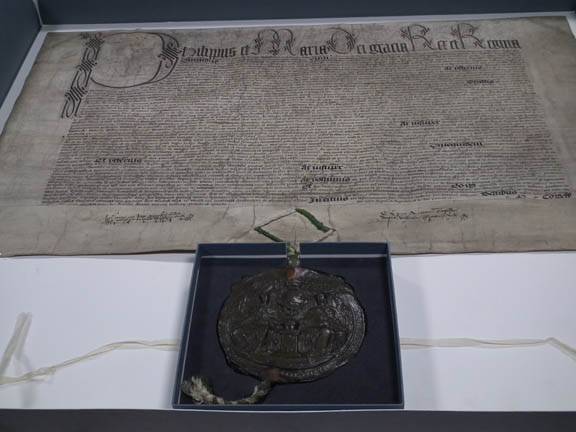The book ‘She-Wolves: England’s Early Queens,’ has been made into a three-part television series and the final episode was shown on BBC 4 last night. The series takes a look at the reign of seven queens of medieval and Tudor England and their struggle in a male-dominated monarchy.
In her book, Dr Helen Castor includes an illustration of the rear side of the Great Seal of Philip and Mary I, an original copy of which can be found attached to document DL 10/422. In this final episode Dr Helen Castor made a visit to The National Archives to take a look at this seal as it depicts Mary I in a more authoritative position than Philip.
The term ‘Great Seal’ is given to seals used by monarchs to authorise official documents, which were held in the custody of the Chancellor. A new great seal was made for each reign, with old seals ceremonially broken up once the reign had ended. This particular seal is 454 years old and is available to view at our reading rooms in Kew for any visitor with a valid readers ticket.

This is not the only original source to be televised recently. Did you see AIR 8/1356, a 1941 night analysis from Bomber Command that Ewan McGregor came to see, which was broadcast on 06 February in BBC1’s ‘Bomber Boys’? Or E101/44/30, a list of the sick and wounded sent home after the siege of Harfleur, which was televised in ‘Bullets, Boots and Bandages’ on BBC4 on 03 February?
Filming which has taken place at The National Archives gives you the opportunity to see documents you might not have thought of researching, or were unaware that we held and were available to view. Even though I am a member of staff, I hadn’t personally seen some of our treasures – for example the confession of Guy Fawkes, until I was asked to produce them for a film crew.
Hopefully these programmes motivate you and help you with your research. If the seal has inspired you, then take a look through our 3,000 images of seals that are available through DocumentsOnline, or check out our research guide for seals.
Keep an eye out for us in the future. I will be blogging about programmes we feature in, which documents have been shown and about how filming at The National Archives works from administration to conservation.